Our adult appearance is determined by our childhood nutritional status
What both our parents ate before we were conceived, as well as our prenatal and childhood nutrition impacts not only our adult health, but also determines what we look like. So if you want your kids to grow up healthy and good looking, choose their food carefully.
I had always thought that our appearance was determined by the genes we received from our parents, and that is obviously true, but I had not realized how large a role nutrition played in determining the full potential of our genes until I studied nutrition in a historical context.
The easiest way to understand this is to look at the issue from an architectural point of view. You have the plans for a beautiful and strong building that must be built by a particular date. (The Olympics are coming?)
So, you set out to begin your task, but the materials required are not available in the quantities needed to build it to the specifications in the blue print. This building must be built, so you are forced to alter the plan to make best use of the materials that you do have.
Hopefully better quality materials will come at some point, and you can try and improve the quality of the structure if that happens, but there are no guarantees.
The plans are asking for wide doorways going into large rooms, but because there don’t seem to be any thick, long beams available to support the roof over such large rooms, the rooms must be made smaller to accommodate the strength of the support struts that are available. Suddenly, the beautiful and strong building is looking smaller and more ordinary.
The same thing happens in the human body. Our genes provide the blueprint for a beautiful and strong body, but if we don't provide the raw materials (food) needed to create what is in the blueprint, the body must reallocate its resources and do what it can with what is available.
This shows up in the skull by a narrowing of the width of the head and jaw, resulting in less room for all the teeth. Teeth are forced to fight for bone space and often come in crooked, or they overlap, resulting in large orthodontist bills.
In adult bodies, inadequate raw materials in childhood shows up also as a smaller pelvis and ribcage, and long limbs. Smaller pelvises in women make child birth more difficult. If the bone structure of the trunk is narrow, the internal organs are permanently more squished, and there are potentially smaller openings for nerves and blood vessels heading into the limbs, making them more susceptible to irritation or damage.
Also if the length of the nose is smaller than the forehead to the hairline or the distance between the chin and the bottom of the nose (small middle third), the nasal passages and sinuses may be too small compromising breathing, which has enormous impacts on the health of the body.
Not too much one can do about widening the skull or the pelvis as an adult, which is why feeding our kids properly is so important to preventing these issues later.
In the western world we have plenty of food and most of us eat more than enough calories, yet many of us including our kids are still malnourished. How is that possible?
Weston A. Price came up with the saying "Proteins and fats make us GROW, and carbohydrates make us GO". Our cells are made structurally with protein and fats, while carbohydrates provide most of the energy to run the system.
So if the raw materials needed to build bones are quality animal proteins and fats, and a child is eating a diet too low in those nutrients to fulfill his/her genetic blueprint, his/her body will be forced to decrease the amount of bone it can make.
Bones become thinner, therefore less strong, and generally smaller in size. Because bone forms the framework for our body, an inability to make enough bone while growing compromises our structure and our appearance as adults. It is important to note that one can be quite overweight and still have a small pelvis and ribcage.
Whole sources of carbohydrates provide our body the fuel to it needs to function, and the vegetables in particular are a good source of vitamins, minerals and phyto-nutrients.
Carbohydrates can be converted into protein and fat in the body, and vegetarians that know about how to combine their grains and legumes properly can successfully make up all the amino acids (building blocks of protein) needed to make cells.
A few vegetarians might be able to get enough protein this way to keep their structure healthy over the long term. I think it is risky to put growing children on vegetarian diets, because if the child needs more protein and saturated fat than a vegetarian diet can provide, their skeleton will be compromised. Most of us being omnivores, really do need to eat enough flesh foods and animal fats to obtain the raw materials to grow and keep our structure strong.
The problem with the current grain-based diet recommendations is that many of us are eating too many processed grains in the form of flour as well as sugars at the expense of vegetables, grass-fed proteins, wild fish and animal fats, so despite eating plenty of calories, our cells are malnourished.
For example, a common breakfast might be Shredded Wheat with skim milk, a glass of orange juice and perhaps a piece of toast with jam. Except for some protein in the milk, everything else in this meal is carbohydrate – and the least healthy kind of carbohydrate at that.
These foods turn into sugar very quickly in the body causing a spike of insulin, which will then store that blood sugar as body fat unless the individual exercises. In addition, high sugar diets pull calcium from the bones further compromising bone integrity. There is no animal fat in this meal, so none of the fat soluble vitamins will be absorbed, and no calcium will be able to get into the bones. Even the orange juice doesn't contribute much to nourish the body unless it is fresh squeezed, as pasteurized juices have next to no vitamins left in them, and are best considered as flavoured sugar water.
Compare that breakfast to one made up of a small bowl of steel cut oats soaked overnight then cooked and served with whole milk, and a fried egg served on a bed of steamed spinach with some cherry tomatoes on the side. One gets protein and animal fats in the egg and dairy, carbohydrates in the oatmeal and veggies, along with lots of vitamins and minerals in the veggies and fats. This meal will probably keep one satisfied longer because it is more nourishing.
If you are hungry within two hours of your previous meal, most likely that meal did not give your cells adequate nutrition. They are starving for something, and that something is probably NOT more flour and sugar.
If you want to subscribe or search for other posts by title or by topic, go to www.wellnesstips.ca. If you want to share this article, click on the “share” button below, at the bottom of the references
Related Tips
Food, our raw material
Food-Guide Fallacy
How good are you at choosing healthier fats?
Getting healthy food into kids
Diet intervention for overweight and obese kids
Saturated fat – the misunderstood nutrient
Taubes, Gary Good Calories, Bad Calories: Fats, Carbs, and the Controversial Science of Diet and Health (Vintage) Alfred A Knopf, New York, 2007.
Dr. Price, Weston A. Nutrition and Physical Degeneration Price Pottenger Foundation, 1939-2006.
Fallon, Sally Nourishing Traditions: The Cookbook that Challenges Politically Correct Nutrition and the Diet Dictocrats New Trends Publishing, 2001.
Pottenger, Francis M Pottenger’s Cats: A Study in Nutrition Price Pottenger Nutrition Foundation, 1995.
Copyright 2010 Vreni Gurd
To subscribe go to www.wellnesstips.ca
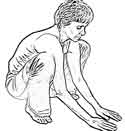
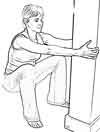 1. Squat to the Floor We should be able to easily spend time in a deep squat keeping our heels down without falling backwards, body leaning between the legs as if we were pooping in the woods. If you cannot do this, try holding onto a sturdy post and lower yourself down leaning back just enough to keep your heels on the floor. You can always sit on a low step-stool for extra support and to make the position more relaxing. Keep your knees in line with your toes, ease into a stretch and wait for it to dissipate. In addition to pushing through your feet you can use your arms to help pull you up when you are done. (Please note: NEVER do a squat to the floor with added weight. Avoid if you have a disk problem in your back.)
1. Squat to the Floor We should be able to easily spend time in a deep squat keeping our heels down without falling backwards, body leaning between the legs as if we were pooping in the woods. If you cannot do this, try holding onto a sturdy post and lower yourself down leaning back just enough to keep your heels on the floor. You can always sit on a low step-stool for extra support and to make the position more relaxing. Keep your knees in line with your toes, ease into a stretch and wait for it to dissipate. In addition to pushing through your feet you can use your arms to help pull you up when you are done. (Please note: NEVER do a squat to the floor with added weight. Avoid if you have a disk problem in your back.)
 2. Tripod Split Squat From the squat position above, drop one knee to the floor and sit on the heel of that foot. This position is comfortable and stable as you have created a triangle on the ground with the points being one knee, the toes of the same leg and the other foot. Make sure you switch sides to work on both legs. This is the ideal position for lifting heavy objects off the floor as one can straddle the object being lifted thereby keeping it close to our body, the spine has a neutral curve, and it forces the use of the legs rather than the back to get up. But it requires good toe flexibility which is usually the limiting factor in this position. If this is too painful, work on your toe flexibility by going onto all 4s, tucking your toes under and leaning back until you can sit on your heels. Toe spreaders can also be very helpful.
2. Tripod Split Squat From the squat position above, drop one knee to the floor and sit on the heel of that foot. This position is comfortable and stable as you have created a triangle on the ground with the points being one knee, the toes of the same leg and the other foot. Make sure you switch sides to work on both legs. This is the ideal position for lifting heavy objects off the floor as one can straddle the object being lifted thereby keeping it close to our body, the spine has a neutral curve, and it forces the use of the legs rather than the back to get up. But it requires good toe flexibility which is usually the limiting factor in this position. If this is too painful, work on your toe flexibility by going onto all 4s, tucking your toes under and leaning back until you can sit on your heels. Toe spreaders can also be very helpful.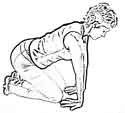
 3. Kneeling Come down onto all fours, tops of the feet down, but turn your hands around so the fingers are pointing back at your knees, palms down. Gently lean back to get a mild stretch in the forearms. When this range of motion is lost we lose the ability to weight-bear through our hands. When you have had enough of that, take the hands off the floor and sit down fully on your ankles and heels to stretch out the tops of the feet and front of the lower legs. If you can't sit all the way back, put your hands on the floor and lean back as much as you need to get a stretch. Once you can sit comfortably like this on the floor, you will be able to interact much more easily with babies and toddlers. Also being able to get up and down from the floor easily will keep your legs stronger than they otherwise would be.
3. Kneeling Come down onto all fours, tops of the feet down, but turn your hands around so the fingers are pointing back at your knees, palms down. Gently lean back to get a mild stretch in the forearms. When this range of motion is lost we lose the ability to weight-bear through our hands. When you have had enough of that, take the hands off the floor and sit down fully on your ankles and heels to stretch out the tops of the feet and front of the lower legs. If you can't sit all the way back, put your hands on the floor and lean back as much as you need to get a stretch. Once you can sit comfortably like this on the floor, you will be able to interact much more easily with babies and toddlers. Also being able to get up and down from the floor easily will keep your legs stronger than they otherwise would be. 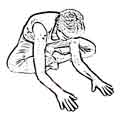
 4. Cross-legged sit with forward bend Sit down on the floor and bring one heel into your perineum, and the other heel just in front of that foot. Your knees should be wide and your legs should feel relaxed. If not, try sitting on a phone book or pillow so that your knees are lower than your pelvis. Now lean forward and if possible, rest your elbows and forearms on the floor in front of you, keeping your sit bones down. If not possible, rest your hands on the floor. Avoid the temptation to look up, which would shorten the back of the neck. Most likely you will feel a stretch in the hip of the forward leg, and possibly the inner thighs and low back. Switch the feet to keep the other hip limber too. (Avoid bending forward if you have a disk problem.)
4. Cross-legged sit with forward bend Sit down on the floor and bring one heel into your perineum, and the other heel just in front of that foot. Your knees should be wide and your legs should feel relaxed. If not, try sitting on a phone book or pillow so that your knees are lower than your pelvis. Now lean forward and if possible, rest your elbows and forearms on the floor in front of you, keeping your sit bones down. If not possible, rest your hands on the floor. Avoid the temptation to look up, which would shorten the back of the neck. Most likely you will feel a stretch in the hip of the forward leg, and possibly the inner thighs and low back. Switch the feet to keep the other hip limber too. (Avoid bending forward if you have a disk problem.)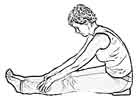 5. Seated forward fold Sit tall on your sit bones on the floor with your legs stretched out in front of you. If possible, gently fold forward keeping the knees soft and collar bones wide, until you feel a mild stretch in the back of your legs. Some people are able to relax with their chest on their thighs, while many of us may not be able to fold forward at all. If you are sitting behind your sit bones, sit on a phone book or pillow to raise you enough to make it possible for you to relax on your sit bones. Sitting on a block with your back against a wall to provide some support may be a very good starting point as one can easily relax and spend time in that position. (If you have a disk problem you need hamstring stretching, but this is not the best choice for you. See a physio, CHEK Practitioner or personal trainer who can teach you a hamstring stretch that keeps your spine in neutral.)
5. Seated forward fold Sit tall on your sit bones on the floor with your legs stretched out in front of you. If possible, gently fold forward keeping the knees soft and collar bones wide, until you feel a mild stretch in the back of your legs. Some people are able to relax with their chest on their thighs, while many of us may not be able to fold forward at all. If you are sitting behind your sit bones, sit on a phone book or pillow to raise you enough to make it possible for you to relax on your sit bones. Sitting on a block with your back against a wall to provide some support may be a very good starting point as one can easily relax and spend time in that position. (If you have a disk problem you need hamstring stretching, but this is not the best choice for you. See a physio, CHEK Practitioner or personal trainer who can teach you a hamstring stretch that keeps your spine in neutral.)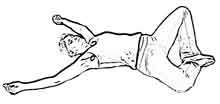 6. Supine butterfly with T-Y-I relax Lie on the floor on your back and lean the soles of your feet into each other, heels close to the perineum, possibly creating a stretch in your inner thighs. If the stretch is too great for the inner thighs, play with the distance your heels are from your perineum, or use pillows for support under your knees. If your head is tilted back to reach the floor, use a pillow so you can keep the plane of your face horizontal. Hopefully eventually you won't need the pillow. Rest your arms out to the side like the letter T, raising them up as high as you can while keeping them on the floor. Perhaps you will be forming the letter Y with your arms and trunk. The goal is to eventually have your upper arms up against your ears like the letter I, yet relaxed on the floor and feeling no stretch in your chest or armpits.
6. Supine butterfly with T-Y-I relax Lie on the floor on your back and lean the soles of your feet into each other, heels close to the perineum, possibly creating a stretch in your inner thighs. If the stretch is too great for the inner thighs, play with the distance your heels are from your perineum, or use pillows for support under your knees. If your head is tilted back to reach the floor, use a pillow so you can keep the plane of your face horizontal. Hopefully eventually you won't need the pillow. Rest your arms out to the side like the letter T, raising them up as high as you can while keeping them on the floor. Perhaps you will be forming the letter Y with your arms and trunk. The goal is to eventually have your upper arms up against your ears like the letter I, yet relaxed on the floor and feeling no stretch in your chest or armpits. 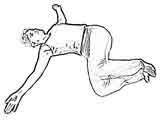 7. Supine torso twist Lie on your back with your arms out to the side, knees bent, feet on the floor. Push through the feet to lift the pelvis up, and place it on the floor slightly to the left. Drop the knees to the right towards the floor, keeping the shoulder-blades down, possibly feeling a stretch in the left side and buttock. Ideally you should be able to relax with the legs on the floor in this deep twist. If you cannot, put pillows under your legs to support them so that you can relax, but still feel a stretch. Do the other side as well.
7. Supine torso twist Lie on your back with your arms out to the side, knees bent, feet on the floor. Push through the feet to lift the pelvis up, and place it on the floor slightly to the left. Drop the knees to the right towards the floor, keeping the shoulder-blades down, possibly feeling a stretch in the left side and buttock. Ideally you should be able to relax with the legs on the floor in this deep twist. If you cannot, put pillows under your legs to support them so that you can relax, but still feel a stretch. Do the other side as well.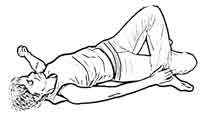 8. Ankle across knee torso twist Lie on your back with your arms out to the side, right knee bent, foot on the floor, left ankle resting on the right thigh so the left knee is pointing out to the side. Slowly drop the right knee down to the right side so that the left foot ends up on the floor and you can hang onto it with your right hand. The left knee should just hang away from the body. You may feel a stretch in the front or side of the left hip. Use pillows for support if needed. Do the other side.
8. Ankle across knee torso twist Lie on your back with your arms out to the side, right knee bent, foot on the floor, left ankle resting on the right thigh so the left knee is pointing out to the side. Slowly drop the right knee down to the right side so that the left foot ends up on the floor and you can hang onto it with your right hand. The left knee should just hang away from the body. You may feel a stretch in the front or side of the left hip. Use pillows for support if needed. Do the other side.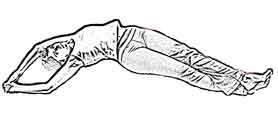 9. Supine C stretch Lie on your back with your legs stretched out, and your hands clasped overhead. Move your legs and arms to the same side so you are taking the shape of a banana, but do not allow your pelvis to rotate. Cross the foot of the leg that is on the outside side of the curve over the foot of the inside leg, relax and feel a gentle stretch through the lateral line of of the body. If you feel any discomfort in your pelvis, try holding in your pelvic floor as if you were stopping the flow of urine and draw in the tissue just above the pubis. Notice any differences side to side.
9. Supine C stretch Lie on your back with your legs stretched out, and your hands clasped overhead. Move your legs and arms to the same side so you are taking the shape of a banana, but do not allow your pelvis to rotate. Cross the foot of the leg that is on the outside side of the curve over the foot of the inside leg, relax and feel a gentle stretch through the lateral line of of the body. If you feel any discomfort in your pelvis, try holding in your pelvic floor as if you were stopping the flow of urine and draw in the tissue just above the pubis. Notice any differences side to side.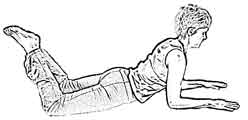 10. Sphinx with lower legs up Lie on your belly and come up onto your elbows, forearms and hands facing forward, elbows at 90 degrees, while keeping your pelvis on the floor. Keep the back of the neck long, chin drawing into the front of the neck slightly. Try to arch your upper back by keeping the collar bones wide, lifting your sternum up and through your arms and feeling a stretch in the belly. If this is comfortable for your low back, try bending your knees so the flats of your feet are facing the ceiling. This position should be quite restful, but if your low back is bothering you, only come up as high as is comfortable, and try supporting your pelvis by drawing in the tissue just above the pubis. For some, lying on the floor with the forehead on the hands may be all that can be initially tolerated. Find the position you can relax in and progress from there.
10. Sphinx with lower legs up Lie on your belly and come up onto your elbows, forearms and hands facing forward, elbows at 90 degrees, while keeping your pelvis on the floor. Keep the back of the neck long, chin drawing into the front of the neck slightly. Try to arch your upper back by keeping the collar bones wide, lifting your sternum up and through your arms and feeling a stretch in the belly. If this is comfortable for your low back, try bending your knees so the flats of your feet are facing the ceiling. This position should be quite restful, but if your low back is bothering you, only come up as high as is comfortable, and try supporting your pelvis by drawing in the tissue just above the pubis. For some, lying on the floor with the forehead on the hands may be all that can be initially tolerated. Find the position you can relax in and progress from there. Facebook Wellness-Tips Page
Facebook Wellness-Tips Page